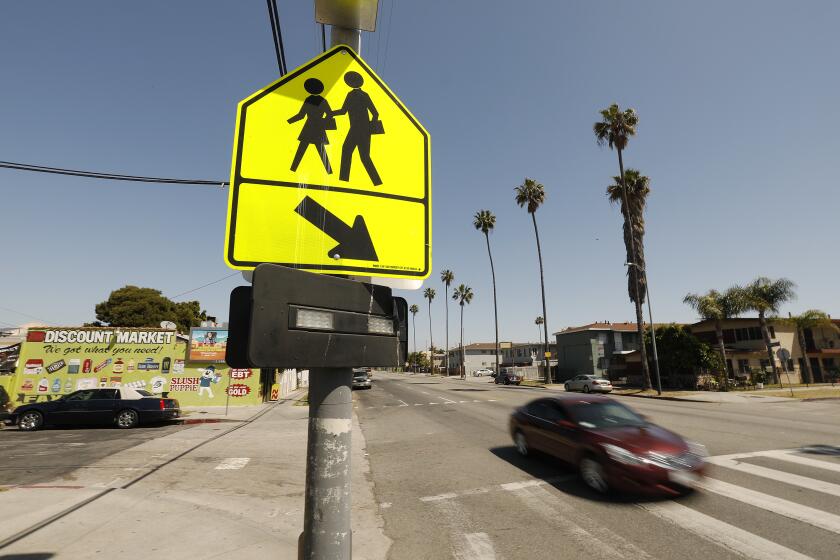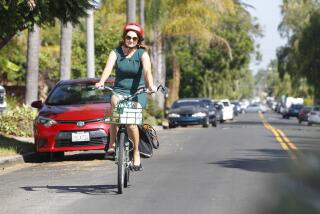Column: Is turning right on a red light your California birthright? Absolutely not!

It’s dangerous out there on the mean streets of, well, just about any city where cars and pedestrians interact.
Over the last decade, all U.S. traffic deaths have increased by 13%, according to the Governors Highway Safety Assn., but pedestrian deaths have risen by a whopping 54%.
And no one knows exactly why.
In an attempt to reverse the deadly trend, cities are seeking ways to intervene. One promising change that’s catching on: prohibiting drivers from turning right on red lights.
Last week, Berkeley joined the effort with an initial City Council vote. It follows San Francisco, San Jose, Ann Arbor, Mich., and Washington, D.C., all of which have taken steps to reduce the risk of cars crashing into pedestrians and cyclists by, to one degree or another, outlawing rights on reds.
“Policies like eliminating right on red are smart and easy ways to begin the process of deprioritizing car use in Berkeley and placing lives above driver convenience,” Berkeley Councilmember Terry Taplin wrote in his proposal.
So far, the data are promising.
A study of a pilot program testing the ban in Washington, D.C., found that the number of times drivers failed to yield to pedestrians when the light was red dropped dramatically, according to Route Fifty, a website that covers tech and innovation in states and cities. Weirdly, the study also found that 30% more drivers encroached on the crosswalk as they inched forward trying to turn right. That, said the study authors, was probably because those drivers started to turn at the red light but then realized it was illegal and got stuck in the crosswalk.
The Berkeley City Council approved an initial proposal that would ban drivers from turning right at a red light as a way to protect pedestrians and bicyclists.
“As a pedestrian, you have a light to cross the street, but you have a driver who’s inching out into the intersection looking in exactly the opposite direction to see if there are any cars coming,” Colin Browne of the Washington Area Bicyclist Assn. told Route Fifty. “So you have to decide: Is this person going to see me or not?”
Personally, I think the ban is a good idea and would love to see it enacted in Los Angeles.
I bet I’m not the only driver who feels a twinge of anxiety when the light turns red as I approach a right turn. There’s a lot of information to absorb. Is someone crossing the street in front of me? Is a cyclist coming up behind me on my right side in the bike lane? Are the drivers who are stopped behind me getting antsy because I haven’t turned yet? And why does this all feel so intense?
When I see a sign prohibiting a right turn on a red light, I am relieved. One less stress point in my life behind the wheel.
Although all states allow right turns on red lights, many Californians in particular consider the practice their birthright. Perhaps we claim the rule as our own because California was probably the first state to embrace the practice, in 1939.
Traffic deaths climbed again in Los Angeles in 2021, raising doubts about Mayor Eric Garcetti’s program to end such fatalities by 2025.
During the energy crisis of 1973, when drivers lined up to buy gas on specified days, traffic engineers came up with the dubious (to me, anyway) proposition that allowing right turns on red lights would save fuel. The federal government codified the practice in the Energy Policy and Conservation Act of 1975 when it required states to permit right turns on red lights in order to receive federal assistance for mandated conservation programs.
That seems pretty dumb in retrospect, and yet another example of how the automobile has always been prioritized over pedestrian safety in our car-obsessed culture.
“Permitting right turns on red has always been a dangerous idea, which is why, when the first traffic lights and traffic laws rolled out, it was not allowed,” Jessie Singer told me in an email Thursday. Singer literally wrote the book on how “accidents” happen in America. “It is no coincidence,” she continued, “that in New York City, the most pedestrian-dense city in the U.S., right on red has long and largely been disallowed.”
The practice is inherently dangerous to pedestrians because, as Singer puts it, it “leaves the sanctity of the crosswalk and the life of a pedestrian in the hands of a fallible driver.”
Californians will have greater freedom to jaywalk without the threat of a ticket.
In Singer’s book, “There Are No Accidents: The Deadly Rise of Injury and Disaster — Who Profits and Who Pays the Price,” she argues that the tragedies we consider “accidents” are almost always preventable.
“In the so-called ‘accident-prone’ areas of our lives,” she told me, “we can protect people by reducing their exposure to harm. One way that harm is introduced is when we take a safe system, like the rule that red means stop, and modify it to serve feelings like convenience or desire — suddenly the rule is a matter of opinion and judgment, a choice about feelings of safety to be made again and again by individual drivers, and whim to their mood, their needs, or the quality of their day.”
Berkeley’s ban awaits another funding vote before the city starts posting “no right turn on red” signs at all its intersections with lights. The council members are braced for “pushback,” but they’re right: Outlawing rights on reds is an easy, cost-effective way to save lives.
Los Angeles, are you listening?
More to Read
A cure for the common opinion
Get thought-provoking perspectives with our weekly newsletter.
You may occasionally receive promotional content from the Los Angeles Times.















